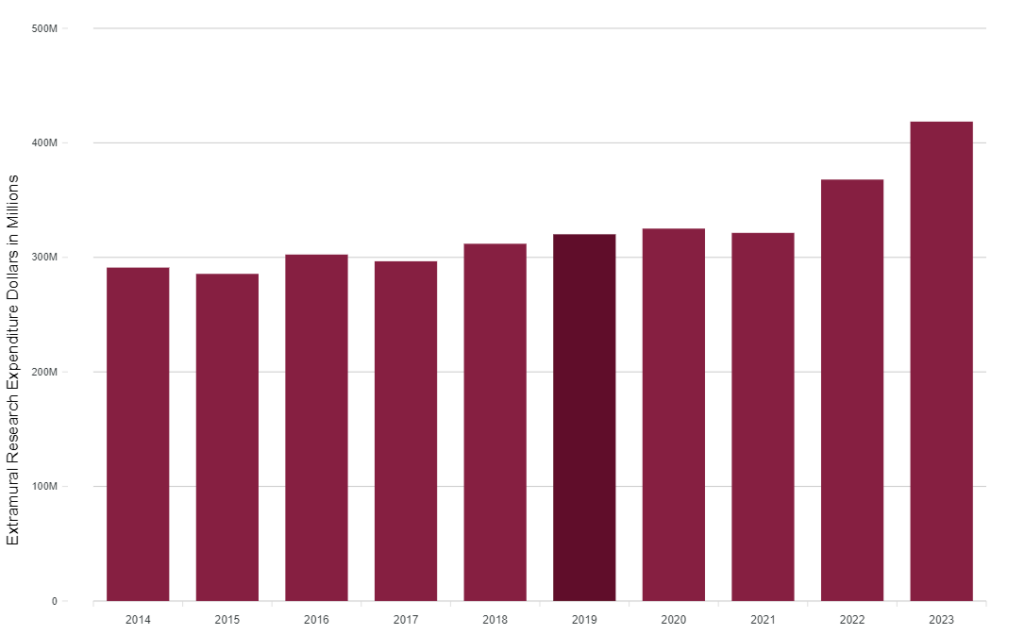Virginia Tech reported a record $419 million in extramural research expenditures for fiscal year 2023, surpassing the university’s strategic plan goal of $410 million two years earlier than planned.
This research growth was fueled by scholarship, creative activities, and innovation addressing critical challenges ranging from wireless technologies, artificial intelligence, climate resilience, infectious disease, invasive species, security, microelectronics, and whole health across all university colleges and research institutes.
The university’s Board of Visitors received this historic news in a June 10 report from Senior Vice President for Research and Innovation Dan Sui.
“Virginia Tech’s research ecosystem is thriving. We are able to maintain this momentum because our world class faculty are committed to innovating and collaborating across traditional boundaries of research through creative activities while also being nimble and evolving with technology,” said Sui, who is also the university’s chief research and innovation officer.
For a second straight year, Virginia Tech’s research awards and expenditures grew more than 10 percent with federal, state, local, and private research awards growing at a combined 17 percent. Between FY21 and FY23, sponsored research awards increased by 31 percent and expenditures increased by 28 percent.
Sui noted several key metrics that contributed to research growth:
- The Department of Defense and Department of Health and Human Services, the latter of which includes the National Institutes of Health, both grew significantly, each by 27 percent from the last year.
- For colleges’ sponsored research growth, the College of Engineering increased by $28 million, the College of Science increased by $14 million, the College of Agriculture and Life Science increased by $11 million, and the Virginia-Maryland College of Veterinary Medicine increased by $9 million over the past five years.
- Three of the seven research institutes also reported significant growth since 2020. The Fralin Biomedical Research Institute at VTC increased by $16 million, the Virginia Tech National Security Institute increased by $15 million, and the Virginia Tech Transportation Institute increased by $8 million.
He also highlighted frameworks for supporting Virginia Tech faculty that enables transformative research:
- Strategic areas of growth, such as Virginia Tech’s Research Frontiers, are broad areas where scholarly expertise aligns with national and international trends. Emphasizing these areas provides the university the opportunity to increase its international standing, maximize its global impact, and gain significant external funding.
- Complementary to strategic areas of growth are competitively awarded investment mechanisms, such as Destination Area 2.0 projects, that support collaborative, transdisciplinary research, teaching, and outreach efforts that strengthen and deploy expertise and assets of the university to address compelling problems of global importance.
Sui pointed to recent examples of success, including the National Security Institute securing $17 million over the next two years to collaborate with the U.S. Navy and industry to test autonomous undersea robotics. Also, the Commonwealth Cyber Initiative (CCI) has become a key contributor to the Wireless Innovation Fund managed by the National Telecommunications and Information Administration. The CCI xG Testbed is an integral part of the initiative’s wireless innovation strategy and a unique platform for testing and experimentation with the interoperability and security of open networks.
“As a land-grant university, we have a unique responsibility to use our knowledge, experience, and expertise to identify solutions to complex challenges facing Virginia communities and beyond,” Sui said. “Each and every day I am impressed with the research taking place at Virginia Tech to create a better tomorrow.”
Sponsored research expenditures
For fiscal year 2023, Virginia Tech reported a record $419 million in extramural research expenditures surpassing the university’s strategic plan goal of $410 million two years earlier than planned.


